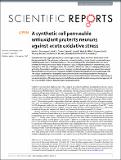A synthetic cell permeable antioxidant protects neurons against acute oxidative stress
Abstract
Excessive reactive oxygen species (ROS) can damage proteins, lipids, and DNA, which result in cell damage and death. The outcomes can be acute, as seen in stroke, or more chronic as observed in age-related diseases such as Parkinson’s disease. Here we investigate the antioxidant ability of a novel synthetic flavonoid, Proxison (7-decyl-3-hydroxy-2-(3,4,5-trihydroxyphenyl)-4-chromenone), using a range of in vitro and in vivo approaches. We show that, while it has radical scavenging ability on par with other flavonoids in a cell-free system, Proxison is orders of magnitude more potent than natural flavonoids at protecting neural cells against oxidative stress and is capable of rescuing damaged cells. The unique combination of a lipophilic hydrocarbon tail with a modified polyphenolic head group promotes efficient cellular uptake and moderate mitochondrial enrichment of Proxison. Importantly, in vivo administration of Proxison demonstrated effective and well tolerated neuroprotection against cell loss in a zebrafish model of dopaminergic neurodegeneration.
Citation
Drummond , N , Davies , N , Lovett , J E , Miller , M , Cook , G , Becker , T , Becker , C , McPhail , D & Kunath , T 2017 , ' A synthetic cell permeable antioxidant protects neurons against acute oxidative stress ' , Scientific Reports , vol. 7 , 11857 . https://doi.org/10.1038/s41598-017-12072-5
Publication
Scientific Reports
Status
Peer reviewed
ISSN
2045-2322Type
Journal article
Description
Funding: Royal Society University Fellowship and grant (RF 120645) (JEL).Collections
Items in the St Andrews Research Repository are protected by copyright, with all rights reserved, unless otherwise indicated.

